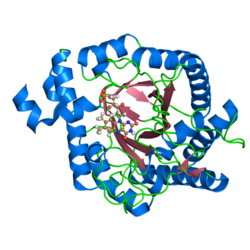Biology:NADPH dehydrogenase
From HandWiki
| NADPH dehydrogenase | |||||||||
|---|---|---|---|---|---|---|---|---|---|
 | |||||||||
| Identifiers | |||||||||
| EC number | 1.6.99.1 | ||||||||
| CAS number | 9001-68-7 | ||||||||
| Databases | |||||||||
| IntEnz | IntEnz view | ||||||||
| BRENDA | BRENDA entry | ||||||||
| ExPASy | NiceZyme view | ||||||||
| KEGG | KEGG entry | ||||||||
| MetaCyc | metabolic pathway | ||||||||
| PRIAM | profile | ||||||||
| PDB structures | RCSB PDB PDBe PDBsum | ||||||||
| Gene Ontology | AmiGO / QuickGO | ||||||||
| |||||||||
In enzymology, a NADPH dehydrogenase (EC 1.6.99.1) is an enzyme that catalyzes the chemical reaction
- NADPH + H+ + acceptor [math]\displaystyle{ \rightleftharpoons }[/math] NADP+ + reduced acceptor
The 3 substrates of this enzyme are NADPH, H+, and acceptor, whereas its two products are NADP+ and reduced acceptor.
This enzyme belongs to the family of oxidoreductases, specifically those acting on NADH or NADPH with other acceptors. It has 2 cofactors: FAD, and FMN.
Nomenclature
The systematic name of this enzyme class is NADPH:acceptor oxidoreductase. Other names in common use include
- NADPH2 diaphorase
- NADPH diaphorase
- old yellow enzyme
- diaphorase
- dihydronicotinamide adenine dinucleotide phosphate dehydrogenase
- NADPH-dehydrogenase
- NADPH-diaphorase
- NADPH2-dehydrogenase
- old yellow enzyme
- reduced nicotinamide adenine dinucleotide phosphate dehydrogenase
- TPNH dehydrogenase
- TPNH-diaphorase
- triphosphopyridine diaphorase
- triphosphopyridine nucleotide diaphorase
- NADPH2 dehydrogenase
- NADPH:(acceptor) oxidoreductase.
References
- The Enzymes. 7 (2nd ed.). New York: Academic Press. 1963. pp. 477–494.
- "Some further investigations on chloroplast TPNH diaphorase". Archives of Biochemistry and Biophysics 72 (1): 17–24. November 1957. doi:10.1016/0003-9861(57)90169-8. PMID 13471057.
- "Chloroplast TPNH diaphorase". Methods Enzymol. 6: 430–434. 1963. doi:10.1016/0076-6879(63)06200-5.
- "Das gelbe Oxydationsferment". Biochem. Z. 278: 263–290. 1935.
- "Molecular weight and FMN content of crystallin old yellow enzyme". Archives of Biochemistry and Biophysics 65 (1): 439–448. November 1956. doi:10.1016/0003-9861(56)90204-1. PMID 13373435.
- Medical Physiology. 2008.
Further reading
- "Enzyme Menthol deghydrogenase". 2005. http://mousecyc.jax.org:1555/META/NEW-IMAGE?type=ENZYME-IN-RXNDISPLAY&object=MONOMER-6721&detail-level=3.
- "Removal of ferredoxin:NADP+ oxidoreductase from thylakoid membranes, rebinding to depleted membranes, and identification of the binding site". The Journal of Biological Chemistry 261 (26): 12154–8. September 1986. PMID 3745183.
 |

